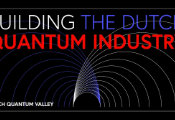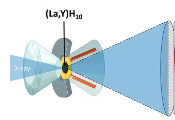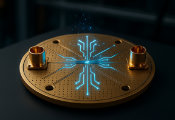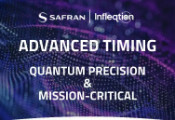World’s First Superconducting Flux Qubit Operating Without Magnetic Field
October 15, 2024 -- The National Institute of Information and Communications Technology (NICT, President: TOKUDA Hideyuki, Ph.D.), NTT Corporation (NTT, President: Mr. SHIMADA Akira), Tohoku University (President: Dr. TOMINAGA Teiji) and the Tokai National Higher Education and Research System Nagoya University (President: Dr. SUGIYAMA Naoshi) succeeded in developing a new type of superconducting flux qubit that operates in zero magnetic field.
Conventional superconducting flux qubits require an external magnetic field generated by bulky coils or an additional local flux bias line near the qubit. The newly developed superconducting flux qubit using a ferromagnetic Josephson junction (named π-junction) demonstrates the realization of a flux qubit operating at zero magnetic field. The qubit lifetime is in the microsecond range, which is the longest among the superconducting qubits with ferromagnetic π-junction. By further improving the ferromagnetic junction material in the future, this π-junction and flux qubit that can operate in zero magnetic field may become essential elements of high-performance quantum devices that are indispensable for quantum computers.
This result was published in the British scientific journal “Communications Materials” on October 11, 2024.
Background
In the information technology of the future, quantum computers are expected to play a crucial role in various fields, from material and pharmaceutical development to information security. Among the promising technologies, superconducting qubits stand out for their relatively easy control of quantum states. Josephson junctions, which are essential components of superconducting qubits, provide anharmonicity to the circuit, enabling qubit operation. The characteristics of a few representative superconducting qubits are shown in Table 1.
Transmon qubits, widely used today for superconducting quantum computers, have low anharmonicity, which may cause problems such as frequency crowding when integrating many qubits.
On the other hand, flux qubits, which use three Josephson junctions, have higher anharmonicity and can mitigate frequency crowding problems. However, flux qubits require external coils to apply half a magnetic flux quantum (Φ0 = 2.07×10-15 Wb) to the superconducting loop for optimal operation, leading to challenges like low-frequency noise from the coils or the need for additional control lines for each qubit, hindering large-scale integration.
To address this, researchers at Tohoku University, led by Prof. Taro Yamashita (then at Nagoya University), proposed incorporating a π-junction into the flux qubit. This π-junction, which uses a ferromagnetic Josephson junction, generates a 180-degree (π) phase difference without external magnetic fields, allowing the qubit to reach its optimal operating point spontaneously. This is expected to reduce external noise, simplify the circuit, and make qubit integration easier.
Achievements
In this study, we combined NICT's nitride superconducting qubit technology, based on niobium nitride (NbN) grown on silicon substrates (as reported by NICT press release on September 20, 2021), with the technology for ferromagnetic Josephson devices (as reported by NICT press release on November 15, 2017). This integration allowed us to develop a flux qubit with a π-junction. We successfully demonstrated that this flux qubit with a π-junciton can operate optimally at zero magnetic field and elucidated its coherence properties.
Previous studies include the work of Prof. Alexey Ustinov's research team at the Karlsruhe Institute of Technology (Germany), who reported a coherence time of 4 nanoseconds in a phase qubit composed of Nb/AlOx/Nb Josephson junctions and Nb/CuNi/Nb π-junctions. Additionally, they attempted to introduce a π-junction into a flux qubit, but did not observe quantum coherent qubit operation.
In our research, we utilized PdNi, which maintains a more stable π-state than CuNi, to form a π-junction on an NbN electrode. Furthermore, we combined NICT's NbN/AlN/NbN Josephson junction technology with NTT's optimal design for flux qubits in 3D cavity resonators to develop a new type of flux qubit that operates optimally in zero magnetic fields. Measurements using NTT's long-coherence-time qubit measurement system confirmed that the optimal operating point is at zero magnetic field, with a coherence time of 1.45 microsecond. This marks a 360-fold improvement in coherence time compared to phase qubits with π-junctions.
However, conventional flux qubits fabricated without a π-junction exhibit an energy relaxation time of 16 microseconds (as reported by NICT on September 20, 2021), indicating that the π-junction of the current NbN/PdNi/NbN structure negatively impacts quantum coherence.
While further improvement in quantum coherence is still needed, this achievement represents the world's first realization of a flux qubit that does not require an external magnetic field and exhibits a coherence time on the order of microseconds. This technology is a crucial step toward miniaturizing and integrating various quantum circuits, including qubits. By eliminating the need for an external magnetic field, it will contribute to simplifying circuits, saving energy, and reducing costs.
Future prospects
Looking ahead, we aim to optimize the circuit structure and fabrication process to further extend the coherence time and improve the uniformity of device characteristics, with an eye toward future large-scale integration. Our goal is to develop a new platform for quantum hardware that could surpass the performance of conventional aluminum-based qubits. By improving the materials and structure of the ferromagnetic junction, we hope to develop a π-junction flux qubit with longer coherence time that can operate in zero magnetic field. Such advancements could make it a critical component in various quantum technologies, including quantum computer chips.




































